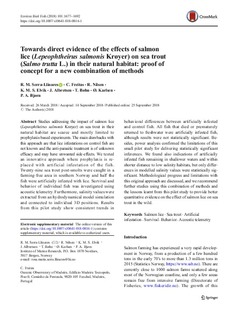| dc.contributor.author | Serra Llinares, Rosa Maria | |
| dc.contributor.author | Freitas, Carla | |
| dc.contributor.author | Nilsen, Rune | |
| dc.contributor.author | Elvik, Kristine Marit Schrøder | |
| dc.contributor.author | Albretsen, Jon | |
| dc.contributor.author | Bøhn, Thomas | |
| dc.contributor.author | Karlsen, Ørjan | |
| dc.contributor.author | Bjørn, Pål Arne | |
| dc.date.accessioned | 2019-01-18T13:57:55Z | |
| dc.date.available | 2019-01-18T13:57:55Z | |
| dc.date.created | 2019-01-11T12:47:00Z | |
| dc.date.issued | 2018 | |
| dc.identifier.citation | Environmental Biology of Fishes. 2018, 101 (12), 1677-1692. | nb_NO |
| dc.identifier.issn | 0378-1909 | |
| dc.identifier.uri | http://hdl.handle.net/11250/2581340 | |
| dc.description.abstract | Studies addressing the impact of salmon lice (Lepeophtheirus salmonis Krøyer) on sea trout in their natural habitat are scarce and mostly limited to prophylaxis-based experiments. The main drawbacks with this approach are that lice infestations on control fish are not known and the anti-parasitic treatment is of unknown efficacy and may have unwanted side-effects. We tested an innovative approach where prophylaxis is replaced with artificial infestation of the fish. Twenty-nine sea trout post-smolts were caught in a farming-free area in southern Norway and half the fish were artificially infested with lice. Survival and behavior of individual fish was investigated using acoustic telemetry. Furthermore, salinity values were extracted from an hydrodynamical model simulation and connected to individual 3D positions. Results from this pilot study show consistent trends in behavioral differences between artificially infested and control fish. All fish that died or prematurely returned to freshwater were artificially infested fish, although results were not statistically significant. Besides, power analysis confirmed the limitations of this small pilot study for delivering statistically significant inferences. We found also indications of artificially infested fish remaining in shallower waters and within shorter distance to low salinity habitats, but only differences in modelled salinity values were statistically significant. Methodological progress and limitations with this original approach are discussed, and we recommend further studies using this combination of methods and the lessons learnt from this pilot study to provide better quantitative evidence on the effect of salmon lice on sea trout in the wild. | nb_NO |
| dc.language.iso | eng | nb_NO |
| dc.title | Towards direct evidence of the effects of salmon lice (Lepeophtheirus salmonis Kr?yer) on sea trout (Salmo trutta L.) in their natural habitat: proof of concept for a new combination of methods | nb_NO |
| dc.type | Journal article | nb_NO |
| dc.type | Peer reviewed | nb_NO |
| dc.description.version | publishedVersion | nb_NO |
| dc.source.pagenumber | 1677-1692 | nb_NO |
| dc.source.volume | 101 | nb_NO |
| dc.source.journal | Environmental Biology of Fishes | nb_NO |
| dc.source.issue | 12 | nb_NO |
| dc.identifier.doi | 10.1007/s10641-018-0816-1 | |
| dc.identifier.cristin | 1654880 | |
| dc.relation.project | Havforskningsinstituttet: 14650 | nb_NO |
| cristin.unitcode | 7431,17,0,0 | |
| cristin.unitcode | 7431,20,0,0 | |
| cristin.unitcode | 7431,24,0,0 | |
| cristin.unitname | Sykdom og smittespredning | |
| cristin.unitname | Oseanografi og klima | |
| cristin.unitname | Reproduksjon og utvikl.biologi | |
| cristin.ispublished | true | |
| cristin.fulltext | original | |
| cristin.qualitycode | 1 | |
